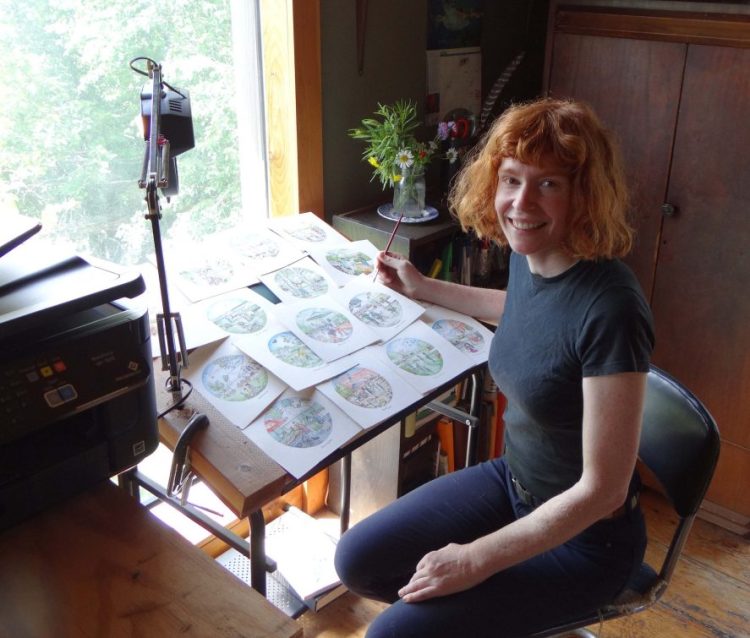When Leigh Hallett, the executive director of the Maine Federation of Farmers’ Markets, was working on a plan to create a trail map for Washington County’s farmers markets – complete with free outdoor activities near all six of the markets – she wanted to include illustrations to personalize each market. She reached out to Steuben artist Nicole DeBarber, a longtime member of the Beehive Collective, who took the photos Hallett sent her along with a few loose descriptions of what the project needed, and ran with it. Hallett liked the results so much, the map has now been expanded through the midcoast. DeBarber’s art work of 20 Maine farmers markets in action will be displayed in Machias starting in late August. We called DeBarber up to talk about the intersection of art, farming and life in Down East Maine.
ANTS TO BEES: DeBarber is a native of Connecticut who moved to Maine about 10 years ago from upstate New York. She’d been in a collective in Rochester, New York, called the Ant Hill, which did have an art component, but also, a community bike shop, a bakery and a deep interest in organic foods. “Everyone had different skills. I was amazed by all the collaboration.” It also planted a seed for the future. “I knew I wanted to keep living collectively.” She heard about the art-focused Beehive Collective from someone at Ant Hill, and in 2008, took a drive up to Machias, looking for an opportunity to be a collaborative artist. “I was always really jealous of musicians because they are always collaborating.”
JOINING IN: How do you join in a collective? Is there an application process? “It feels very organic. People would come and volunteer.” She’d been in Machias a year before she began working on the big project Beehive had going, the Mesoamérica Resiste! artwork that illustrates the problems with globalization of the Americas. “All of their posters are based on research trips and collaboration. I came on that project so late that I had already missed the research trip. They had been working on it for 9 or 10 years.” The Beehive Collective specializes in highly detailed works. “This has about 500 species in it.”
BREAKING BREAD: But she left the collective for another collaboration; farming with a (then) partner. Their farm was Folklore Farm in Columbia. Given the Down East location, we’re guessing blueberries were involved? “Yes! We started out as a blueberry farm.” They added vegetables, but the thin soil that makes for good blueberries? “It was terrible for growing vegetables.” DeBarber began diving deep into work with pollinators, particularly educational programs for local schools about native bees. Today, she lives in Steuben. “At the end of a dead end, where I am building a tiny house art studio.” The friend she lives with now and she are interested in using it for an artist residency, and building a new artistic collaboration on that land. DeBarber continues to volunteer at the Beehive and works with a local group, the Maine Seacoast Mission’s Down East Campus in Cherryfield. According to its website, the Down East food programs served 187,000 meals last year, many of them using local ingredients (pizza is a favorite). The population being served “probably looks really different than what you are used to thinking about.” Such as? A lot of homesteaders who live without electricity or running water and are looking for a hot meal and a sense of community. “Our religion is breaking bread together,” DeBarber said.
SURVIVAL OF THE FITTEST: How does one survive on volunteering and nonprofit work? “I am kind of lucky. I feel like I didn’t ever get used to the idea that I had to kind of hustle. And with the cost of living here, I feel like, if you are OK with having an outhouse…” You have an outhouse? “I do.” And a garden, full of edibles like garlic and mushrooms. “It is kind of a luxury to go from farming to gardening because the scale is so much smaller. You realize you can reach everything with the hose.”
INNER LIFE: She also has an artist’s approach to life and always has. “Even when I was a little kid, I was always making drawings. I grew up right next to a wetland, and I remember I wrote a little story about how the frogs fought off the animals that were trying to mine their land.” (Shades of “Watership Down.”) When Hallett asked her to take on the illustration project, DeBarber had a leg up; she’d been to some of the markets – Machias and Milbridge – as a vendor when she was at Folklore Farm. And she took trips to others and talked to Hallett about the special features inherent to some of the markets. Like the bagpipe player who can reliably be found in Bucksport; he’s in that illustration.
SMALL FORMAT: DeBarber works in watercolor and made the drawings quite small, about 4 inches by 4. “Because they were going to be printed almost postage-stamp size.” This fit with what she’d done at the Beehive – “all small drawings on big paper.”
TRICKS OF THE TRADE: But after the collectives, working alone still feels almost odd. “I am so used to having other people working around me. So I would turn on some kind of marathon reality show, where they are building houses or baking cakes so it would feel like I was in a busy room.”
Mary Pols can be contacted at 791-6456 or at:
Twitter: MaryPols
Send questions/comments to the editors.




Comments are no longer available on this story